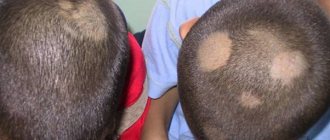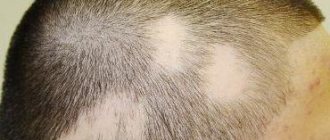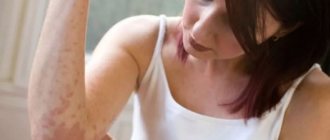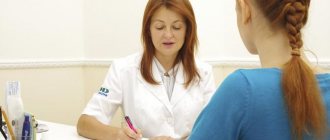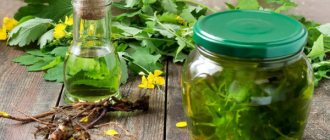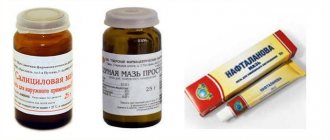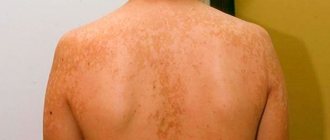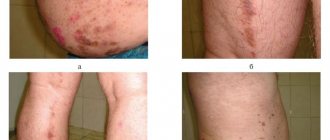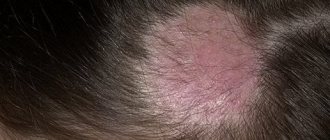An infectious disease such as ringworm is caused by various types of fungi, most often of the Microsporum or Trichophyton genus.
Cost of services in our clinic
| Appointment with a dermatologist, candidate of medical sciences | 1500 rub. |
| Consultation with a dermatologist (KMS) when removing 2 tumors | 0 rub. |
| Removal of a neoplasm (wart, mole) using the radio wave method | 500 rub. |
| Make an appointment by phone: 8-800-707-15-60 (toll-free) |
| *The clinic is licensed to remove tumors |
The disease manifests itself in the form of pinkish, scaly, rounded spots on the skin. The incubation period is one to two weeks from the moment of infection.
Ringworm on a person's hand
The most vulnerable place for lichen infection is the hands. These are the parts of the body that are most in contact with the environment. You can become infected on public transport, from shaking hands or contact with a sick animal. Most often, lichen occurs in people with reduced immunity, after a serious illness or severe stress. Also, the occurrence of lichen may be due to hormonal imbalance.
Here we have already covered the issue of lichen in humans, photos, signs and treatment of different types of this disease..
Reasons for appearance
There are the following reasons for the appearance of lichen on the hands:
- transmission of the disease from a sick person to a healthy person through household contact;
- decreased immunity;
- excessive contact with domestic and street animals;
- failure to comply with personal hygiene rules.
Since there may be several reasons for the appearance of lichen, if this pathology is detected, you should immediately contact a dermatologist and undergo the necessary tests.
You cannot let the disease take its course, as an advanced infection will be much more difficult to treat.
Types of lichen on the hand
The causative agents of lichen in humans are viral and fungal microorganisms.
The following microorganisms cause lichen:
- There are two types of viral lichen: pink or herpes zoster. Microorganisms can remain in the human body for a long time and not define themselves in any way, and at the moment of general weakening of the body or when the nervous system is exhausted, they manifest themselves in the form of lichen.
- Anthropophilic microorganisms are transmitted from an infected person through direct skin contact.
- Geophilic microorganisms are found only in soil; you can become infected by contact with soil
- Zooanthropophilic microorganisms are transmitted from animals. Affects human skin and hair.
Incubation period of the disease
The incubation period of the fungal infection that causes the appearance of ringworm ranges from several days to 6–8 weeks and depends on the type of pathogen that has entered the body.
Superficial lichen may appear as the first symptoms within 5-7 days after infection. Infiltrative-suppurative lichen does not give any clinical manifestations for several months. The first signs of the disease appear no earlier than 6-8 weeks after the pathogen enters the body.
The first signs and types of lichen
Basically, lichen is manifested by the appearance of spots on the skin, which differ in color and structure, and can cause itching and burning of the skin. The area affected by lichen peels off and causes constant discomfort.
When hair loss occurs, patchy baldness can be observed. Some types of lichen affect human nails, they split and change color. On the hands, lichen appears on the wrist and the inside of the palm. The rash also occurs on the elbows and forearm.
Diagnostics
The diagnosis is based on a visual examination of the patient, as well as collecting a medical history and questioning about possible sources of infection. If in doubt, the doctor will scrape the affected area.
The collected materials are examined under a microscope or placed in a nutrient medium for three days, during which rapid growth of fungal colonies is observed. When filaments of mycelium and spores of a fungal pathogen are detected, its identification is made.
Lichen Zhibera (lichen rosea)
Appears on the human body, including spots on the hands and wrists, in the form of pink-brown spots with characteristic peeling in the lesion. Accompanied by severe itching. An important factor for the manifestation of pityriasis rosea is severe hypothermia, mainly in the autumn-winter period. It is often a consequence of a previous cold.
Photo
Drug treatment
The most common drug for the treatment of pityriasis rosea is Acyclovir . This medicine not only stops the development of the disease, but also increases the body's resistance to microorganisms.
For complex treatment it is necessary to take antihistamines:
- Tavegil;
- Suprastin;
- Fenistil.
For external use, an ointment based on birch tar and salicylic-zinc paste is used.
ethnoscience
Traditional recipes:
- To treat pityriasis rosea, compresses made from dry horse sorrel are used . To do this, pour 1 tablespoon of herb with 1 tablespoon of water, steam the mixture in a water bath for 40 minutes and leave. The compress is applied to the affected areas of the skin for 2 hours. Repeat the procedure daily.
- A compress of cabbage and sour cream also helps if you apply it to the sore spot. Keep the compress for 1 hour, apply daily.
- To prevent additional stains from appearing, treat the skin with diluted apple cider vinegar in a ratio of 1 to 2 parts water.
Lichen planus
It appears as red or purple lesions on the human body and nail plates, accompanied by itching. May affect mucous membranes with light pink ulcers.
There are four forms of manifestation of lichen planus:
- ring-shaped – rashes in the form of rings;
- warty;
- erythematous - rash in the form of tubercles;
- erosive-ulcerative - rashes in the form of ulcers and erosions.
Photo
Drug treatment
Drugs for the treatment of lichen planus:
- At the time of exacerbation, antibiotics are prescribed - macrolides, tetracyclines, etc. The dosage is prescribed by the doctor. In parallel with taking antibiotics, it is necessary to take antihistamines.
- If the disease causes nervousness and irritability, you can add valerian or a mild sedative to the general list of medications.
- For external use, ointments based on menthol or anesthesin are used. Be sure to take a complex of vitamins A and E.
ethnoscience
Traditional medicine recipes:
- A compress of crushed dark raisins is recommended.
- An equally effective method is a beet juice lotion. You need to make compresses 2 times a day for 1 hour.
- Sea buckthorn oil is an indispensable assistant in the treatment of lichen planus.
- An effective remedy is baths made from string, chamomile, lavender, celandine, nettle, and calendula. Proportion for preparation: 2 parts of string and chamomile and 1 part of other herbs. Boil the collection, leave for 2 hours, strain, add to the bath. Take the procedure for 10 minutes. Do not dry yourself, let the body dry naturally.
You might be interested! Ringworm in children: types, first signs and treatment
Trichophytosis (ringworm)
Ringworm appears on parts of the body with hair: arms from wrist to elbow, legs to knee and head. The affected areas appear as pink spots with uneven outlines and white peeling. There is no hair on the affected areas. One of the types of ringworm is microsporia.
Photo
Drug treatment
For drug treatment, antifungal ointments, creams or sprays are used:
- Clotrimazole,
- Kanesten,
- Funginal,
- Exoderil,
- Lamisil.
Be sure to treat stains with a five percent iodine solution. You can use Wilkinson's ointment (sulfur, tar) or Lassar's paste (vaseline, starch, salicylic acid, zinc oxide). Treatment is accompanied by taking a general strengthening vitamin complex.
ethnoscience
Traditional medicine recipes:
- To treat trichophytosis and microsporia, it is necessary to rub a mixture of crushed garlic and birch ash into the affected areas of the skin 2-3 times a day.
- If the foci of the disease are on the head, you should prepare a herbal mixture (4 tablespoons of string, 2 tablespoons of celandine, 1 tablespoon of horsetail). Mix everything, pour 4 cups of boiling water, after an hour the tincture is ready. Rub the medicine into the scalp 1-2 times a day.
- A herbal bath has healing properties, for this purpose 100 g. Add dry celandine to 4 liters of water, bring to a boil and leave for 2 hours. Pour into a warm bath. Take the procedure for 10-15 minutes, repeat every other day.
Pityriasis versicolor (tinea versicolor, pityriasis versicolor)
The appearance of this lichen is caused by yeast-like fungi. Appears on the body in spots that are lighter or darker than the main skin tone. This is due to a disruption in the functioning of melanocytes in the human body. In the initial stages, several small spots are observed, and over time they grow, forming large spots with peeling skin.
Photo
Drug treatment
To treat lichen versicolor, use antifungal ointments such as:
- Bifonazole;
- Bifosin;
- Micanazole;
- Salicylic cream;
- Salicylic lotion with chamomile.
If the disease has spread widely throughout the body, you can add drugs to treatment:
- Fungavis;
- Clotrimazole;
- Itraconazole
ethnoscience
Traditional medicine recipes:
- To treat pityriasis versicolor, it is necessary to lubricate the affected areas of the skin with freshly squeezed onion juice. Repeat the procedure 2-3 times a day.
- Burdock oil is considered an equally effective remedy. It must be rubbed into the skin 3 times a day.
- Alcohol tincture of calendula in a ratio of 1:5 will help get rid of multicolored lichen.
Eczema (ringworm)
It mainly affects the hands and face. Accompanied by sensitive itching. It appears as red spots with small blisters containing serous fluid. After the liquid is released, the area becomes covered with a brown crust; the process can be repeated many times. Requires long-term complex treatment.
Photo
Drug treatment
Hormonal ointments and fatty creams are used to treat eczema:
- Elokom;
- Lokoid;
- Advantan.
ethnoscience
Traditional recipes for the treatment of eczema:
- One of the main recommendations is to take baths with sea salt. The saline solution is prepared at the rate of 10 teaspoons of salt per 1 liter of water. After the bath, rinse the saline solution from your body and apply a hypoallergenic cream.
- Kalanchoe juice is considered effective in treating eczema. They should lubricate inflamed areas of the skin.
- For internal use, burdock tincture is used. Pour 1 tablespoon of the herb into 200 ml. boiling water Brew the mixture in a water bath for 15 minutes. Take 10 ml. 2-3 times a day.
Medication
Drug treatment involves visiting a dermatologist, followed by a series of tests and prescription of medications.
The following groups of drugs are widely used:
- antibiotics;
- hormonal ointments;
- antihistamines;
- vitamins.
Psoriasis (scaly lichen)
It appears in the form of protruding papules, with a white scaly covering. Affects almost all areas of the body. Accompanied by pain and itching. During an exacerbation, a person experiences fatigue. It is considered an incurable disease. Complex treatment is prescribed to increase the period of remission and to alleviate the main symptoms.
Photo
Drug treatment
To treat psoriasis use:
- hormonal ointments with tar or salicylic acid (Locacorten, Diprosalik, Lorinden A) or non-hormonal drugs: Oksidevit, Minisan, Aquadetrim;
- tar shampoo or tar soap.
ethnoscience
Traditional medicine recipes:
- For internal use, a tincture of parsley, chicory and dandelion root is recommended. To prepare the tincture, you need to mix the herbs in equal proportions and pour boiling water in the ratio of 150 grams per 1 tablespoon of the mixture. water. Brew in a water bath for 30 minutes. Take 50 ml of the infused solution. 3 times a day.
- You can prepare an ointment. For this, 200 gr. mix butter with 10 g. Boil propolis over low heat for 10 minutes. Apply the resulting mixture to the rash 2 times a day.
Is lichen contagious or not?
Not all types of lichen are contagious.
Species that are not dangerous to others include:
- eczema,
- psoriasis,
- pityriasis,
- lichen planus.
Infectious species include:
- deprive Zhiber,
- ringworm,
- herpes zoster in the initial stages.
It should be remembered that any treatment is effective in combination ; you can combine medications and traditional methods. You should not diagnose the disease yourself if the treatment is not correct, there is a risk of the disease becoming chronic.
Prevention measures
Prevention includes maintaining good personal hygiene and isolating sick animals or people.
At the place where the patient is identified, thorough disinfection is carried out, bed linen and accessories, soft toys, and carpets are subjected to heat treatment. A sick child is not allowed into the children's group until the ringworm is completely cured. Patients are prohibited from visiting swimming pools, saunas, and baths. Kindergarten teachers, nannies, utility workers, and bathhouse attendants are suspended from their duties.
Is ringworm dangerous for humans? The most serious consequences are persistent alopecia areata due to scarring of the skin tissue. The disease should be treated as soon as it begins to manifest itself in order to prevent infection of the immediate environment and reduce the risk of developing a severe allergic reaction.
